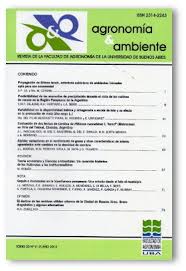Ver ítem
- xmlui.general.dspace_homeCentros Regionales y EEAsCentro Regional CorrientesEEA CorrientesArtículos científicosxmlui.ArtifactBrowser.ItemViewer.trail
- Inicio
- Centros Regionales y EEAs
- Centro Regional Corrientes
- EEA Corrientes
- Artículos científicos
- Ver ítem
Caracterización ecológica cuantitativa de la vegetación arbórea de la costanera de la ciudad de Corrientes, Argentina
Resumen
Se condujo un relevamiento de especies en el sector norte de la costanera correntina durante el año 2022 con el fin de evaluar la diversidad de su arbolado urbano. Se calcularon distintos índices y parámetros para analizar la alfa-diversidad: riqueza específica, frecuencia, cobertura y densidad; los índices de Berger-Parker, de Simpson, de Shannon-Wiener, de equitatividad de Shannon e índices de valor de importancia (IVI) de especies y de familia. Resultó
[ver mas...]
Se condujo un relevamiento de especies en el sector norte de la costanera correntina durante el año 2022 con el fin de evaluar la diversidad de su arbolado urbano. Se calcularon distintos índices y parámetros para analizar la alfa-diversidad: riqueza específica, frecuencia, cobertura y densidad; los índices de Berger-Parker, de Simpson, de Shannon-Wiener, de equitatividad de Shannon e índices de valor de importancia (IVI) de especies y de familia. Resultó que el sector analizado cuenta con 1.076 individuos, expresa una riqueza específica de 56 especies y 51 géneros, representados en 24 familias taxonómicas. Las especies con mayor frecuencia y abundancia fueron Handroanthus heptaphyllus, Jacaranda mimosifolia y Peltophorum dubium; y las de mayor dominancia H. heptaphyllus, P. dubium y Ceiba speciosa. Las familias más representativas, abundantes y dominantes fueron Fabaceae (con un máximo de nueve géneros y 10 especies) y Bignoniaceae (con cinco géneros y seis especies), siendo Malvaceae la más frecuente. El 38% fueron especies nativas y el 62% restante, exóticas. El IVI denotó que la especie y familia con mayor importancia ecológica han sido H. heptaphyllus y Bignoniaceae, respectivamente. Los valores de los índices de Simpson y Berger-Parker indicaron baja dominancia de especies y alta riqueza. Shannon-Wiener posicionó al área con una diversidad baja, mientras que la equitatividad de Shannon indicó una distribución poco equitativa de la cantidad de individuos por especie. Actualmente, la costanera correntina poseería una baja diversidad de especies en el arbolado del sector norte, por lo que se recomienda introducir mayor biodiversidad en futuras intervenciones.
[Cerrar]
A survey of species was conducted in the northern sector of the Corrientes riverside path during the year 2022 in order to evaluate the diversity of its urban trees. Different indices and parameters were calculated to analyze alpha-diversity: tree species richness, frequency, coverage and density; Berger-Parker, Simpson, Shannon-Wiener, Shannon evenness indices, and importance value indices (IVI) of species and family. It turned out that the sector
[ver mas...]
A survey of species was conducted in the northern sector of the Corrientes riverside path during the year 2022 in order to evaluate the diversity of its urban trees. Different indices and parameters were calculated to analyze alpha-diversity: tree species richness, frequency, coverage and density; Berger-Parker, Simpson, Shannon-Wiener, Shannon evenness indices, and importance value indices (IVI) of species and family. It turned out that the sector analyzed has 1,076 individuals, expresses a specific richness of 56 species and 51 genera, represented in 24 taxonomic families. The species with the highest frequency and abundance were Handroanthus heptaphyllus, Jacaranda mimosifolia and Peltophorum dubium; and those of greater dominance H. heptaphyllus, P. dubium and Ceiba speciosa. The most representative, abundant and dominant families were Fabaceae (with a maximum of nine genera and 10 species) and Bignoniaceae (with five genera and six species), with Malvaceae being the most frequent. 38% were native species and the remaining 62% were exotic. The IVI noted that the species and family with the greatest ecological importance have been H. heptaphyllus and Bignoniaceae, respectively. The values of the Simpson and Berger-Parker indices indicated low species dominance and high species richness. Shannon-Wiener ranked the area as low in diversity, while Shannon Evenness index indicated an inequitable distribution of the number of individuals per species. Currently, the Corrientes waterfront would have a low diversity of species in the trees in the northern sector, so it is recommended to introduce more biodiversity in future interventions.
[Cerrar]

Autor
Luna, Claudia Verónica;
Fontana, Maria Laura;
Ortiz, Nicolás Leandro;
Talavera, Gonzalo;
Cristiá, Alejandro Javier;
Fuente
Agronomía & Ambiente. Revista de la Facultad de Agronomía, UBA. 43 (3) : 202-215 (2023)
Fecha
2023-12
Editorial
Facultad de Agronomía, Universidad de Buenos Aires
ISSN
2314-2243
2344-9039 (en línea)
2344-9039 (en línea)
Formato
pdf
Tipo de documento
artículo
Palabras Claves
Derechos de acceso
Abierto
 Excepto donde se diga explicitamente, este item se publica bajo la siguiente descripción: Creative Commons Attribution-NonCommercial-ShareAlike 2.5 Unported (CC BY-NC-SA 2.5)
Excepto donde se diga explicitamente, este item se publica bajo la siguiente descripción: Creative Commons Attribution-NonCommercial-ShareAlike 2.5 Unported (CC BY-NC-SA 2.5)


